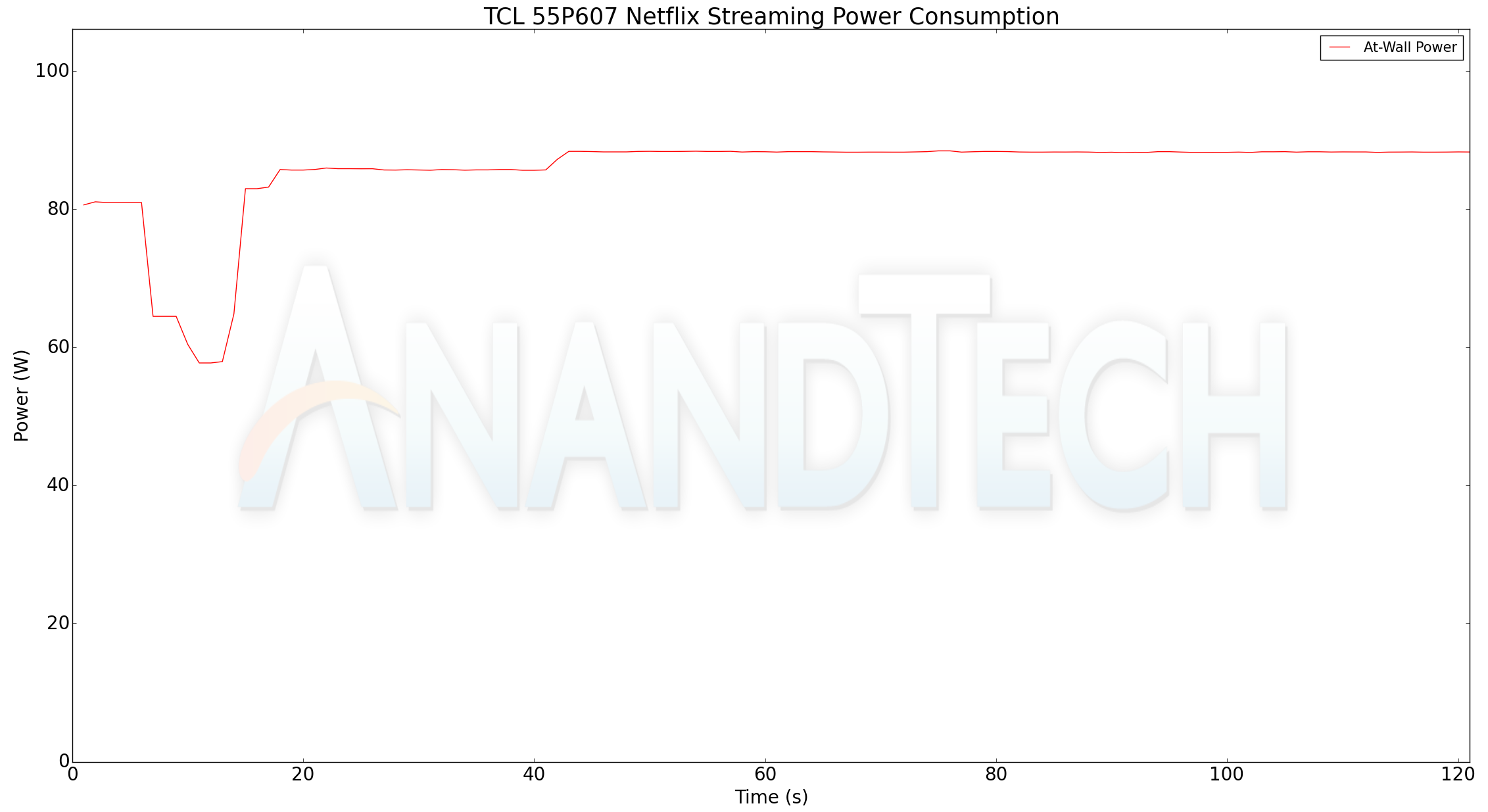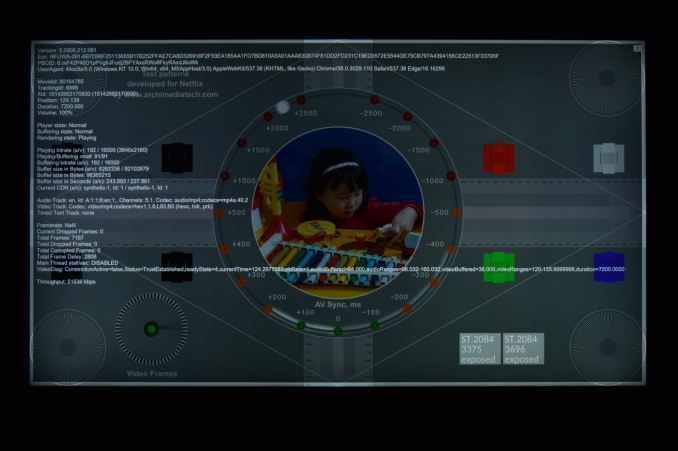A Budget Home Theater & PC Setup: 4K, HDR, UHD Blu-ray, and More
by Ganesh T S on December 26, 2017 8:30 AM ESTNetflix Streaming
We have been using Netflix's El Fuente test clip to evaluate the Netflix streaming capabilities of various HTPCs. Though it does have 4K streams at bitrates of up to 16 Mbps, it doesn't have a HDR version. Our search for a suitable test stream ended with Season 4 Episode 4 of the Netflix Test Pattern series.
The TCL 55P607's Roku platform has a Netflix app. It was able to play the 16 Mbps 4K Dolby Vision version along with Dolby Digital Plus 5.1 audio that was sent back to the receiver using the ARC feature.
Netflix 4K Dolby Vision HDR Stream in the TCL 55P607
Note that the SMPTE text in the boxes are related to the HDR metadata. As we shall see further down, the non-HDR versions of the clip have blank white boxes in that space.
The NVIDIA SATV's Netflix app plays the HDR10 version of the clip, as evident from the stream information detected by the TV.
Netflix 4K HDR10 Stream in the NVIDIA SHIELD Android TV
Our test clip is not suitable for bringing out the advantages of dynamic metadata / Dolby Vision, but, suffice to say that the SATV's Netflix HDR capabilities are compatible with every HDR TV currently in the market.
On the PC front, we have Netflix's 4K HDR working with the natie Windows Store app as well as the Edge browser. We evaluated with the Windows Store app, and the HDR version played back in all three PCs.
Netflix 4K HDR10 Stream in the Windows 10 Netflix Store App
The Windows 10 Netflix playback provides extensive insight into the available streams as well as current playback status. Note the (hevc, hdr, prk) entry corresponding to the Video Track in the debug OSD, as well as the ST.2084 boxes. Playing back the same clip with the desktop in default non-HDR mode plays back the 16 Mbps 4K stream without HDR. Note that we only have (hevc) in the Video Track codec entry, and the ST.2084 boxes are completely blank.
Netflix 4K non-HDR Stream in the Windows 10 Netflix Store App
We also tracked the power consumption of the various playback devices while streaming the HDR version. Similar to the YouTube case, we graph the TCL 55P607 Roku app separately since it involves the display power consumption also.
| Netflix Streaming - Power Consumption | |||

Similar to the YouTube streaming case, we find that the most power efficient of the lot is the ASRock Beebox-S 7200U.














191 Comments
View All Comments
Lord of the Bored - Wednesday, December 27, 2017 - link
He didn't use a DVD player. He used a BluRay player. Completely different.And until streaming gets better bitrates it is an incomplete replacement from a purely technical standpoint. I mean, when regular BR supplies 50 megabits per second, UHD BR is a hundred mbps, and UHD Netflix is 25 mbps, there is OBVIOUSLY a quality sacrifice that has to be made(though the UHD situation is better than HD, where Netflix is a ridiculously compact FIVE mbps. I'll take a quarter the data over a tenth any day).
I mean, if you don't care about image and sound quality, you may as well watch VHS tapes off that old CRT you found in gramma's garage. I always thought home theater builds were about getting the best experience, not a really expensive mediocre experience.
CharonPDX - Wednesday, December 27, 2017 - link
"without worrying about it getting obsolete within the the next 3 to 5 years."JFC... A home theater system should last far longer than 3-5 years...
Bullwinkle-J-Moose - Thursday, December 28, 2017 - link
"JFC... A home theater system should last far longer than 3-5 years..."---------------------------------------------------------------------------------------------
Not with DRM!
A mans gotta know his limitations (Clint Eastwood)
pixelstuff - Wednesday, December 27, 2017 - link
I wish the manufacturers would create a decent set of components (AVR, Blu-ray, etc) that are not more than 8" deep so you can sit them below a wall mounted TV and they don't protrude way out into the room compared to the TV.Wiring would have to be on the sides with a standardized way to hide them, but I don't think extra width would be a big issue when placed under a large TV.
Dionysos1234 - Wednesday, December 27, 2017 - link
Recommending a Denon 999$ reciever is not only NON budget - It is also an extremely poor choice for reciever in that price range from an audio perspective. Guess HTPC is not an area where Anandtech have qualified people e.g. the amount of time devoted to showing poorly made graps on power consumption seems bizarre.Aikouka - Wednesday, December 27, 2017 - link
As for all the remarks about the receiver, my biggest piece of advice is to always buy last year's model UNLESS you absolutely need a feature only on the newest model. For example, I bought an X4300 for less than the article's X3400, and there really aren't any differences that would make me consider swapping.Aikouka - Wednesday, December 27, 2017 - link
As a quick note for the uninitiated, Denon's model numbers work where the thousands place is the model number and the hundreds place is the year. So, the 4300 that I mention above is the 4th-tier model (higher is better) from the third year. The 3400 is the third-tier model from the fourth year. So, mine is a higher model, but it's a year older. To see whether it's worth an upgrade, the AVS Forum's Denon Owner's Threads usually have comparisons to previous years (e.g. X#400 vs. X#300) that can help you decide whether the latest is worth it.r3loaded - Wednesday, December 27, 2017 - link
All I'm getting from this article is that HDR is a mess of confusing and incompatible standards and support, compounded by Hollywood's almost autistic fixation with ramming DRM down the throats of anyone wanting to watch 4K HDR content, and the very specific hardware requirements that it imposes on consumers.Also, why is it that there are tons of HDR TVs on the market but barely any HDR monitors? And conversely, why does no one make a 4K HDR TV smaller than 40 inches (say, 32 inches)? Not all of us are blessed with big houses that can fit the 55 inch TV mentioned in the review.
benedict - Wednesday, December 27, 2017 - link
Yep, sounds like too much trouble for what you're getting and you always risk some weird standard won't work on your expensive setup. Until they make this as simple as torrenting a movie the home theater market will remain a very tiny niche.CityBlue - Wednesday, December 27, 2017 - link
The BDA is expected to announce that the free to licence HDR10+ open standard is being added to the UHD BluRay standard in January at CES, and not the proprietary Dolby Vision. After that announcement I imagine DV will become a niche format. HDR10+ is simply what HDR10 should always have been.HDR10+ (compared with DV) also has a dramatically easier workflow as far as creative's are concerned, so combine that with the reduced licencing cost for manufacturers and there's very little reason to choose DV - the only winner there is Dolby.
It's not yet announced, but recommending DV over HDR10+ may not be such good advice.